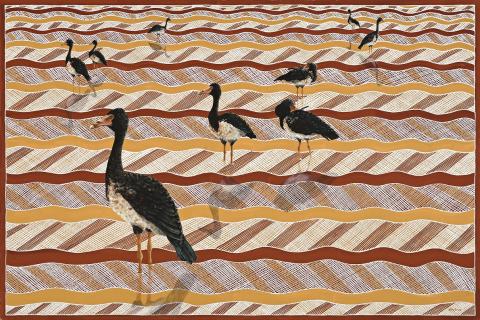GUMINGI (MAGPIE GEESE), 1987
LIN ONUS
synthetic polymer paint on canvas
112.0 x 167.0 cm
signed lower right: Lin Onus
Japingka Gallery, Perth
Private collection, Perth, acquired from the above in 2004
Isaacs, J., Aboriginality: Contemporary Aboriginal Paintings and Prints, University of Queensland Press, Brisbane, 1992, p. 27 (illus.)
In 1986, Lin Onus travelled to Maningrida in Western Arnhem Land with the Aboriginal Arts board, a visit that would have a profound and lasting effect not only on his painting but also, upon his outlook on life. This was the first of sixteen regular 'spiritual pilgrimages' to Maningrida and Garmedi between 1986 and 1996 that introduced him to a spiritual and cultural experience to which he had not previously been exposed. He was introduced to 'kinship systems in which he and his family were assigned skin names, to language that he used for many of the titles of his works and to ceremony and Dreaming stories'.1
Arguably the most important influence upon Onus's stylistic evolution came from the relationship he developed on his trips to Arnhem Land with the highly esteemed Aboriginal painter, Jack Wunuwun. Inspired by the older artist's traditions and bark painting techniques such as rarrk (cross-hatched designs), Onus observed Wunuwun's depth of knowledge about the land, learning the importance of symbols, pattern and designs as well as experiencing the formal process of passing on levels of knowledge. The Yolngu artist, welcomed him into the Murrungun-Djinang clan and gave him permission to use some of the traditional images in his paintings.
Onus had always incorporated a diverse range of mediums, methods and styles in his work: the illustrative qualities of his work being derived from Western culture and the added layered images evolving from his Aboriginal heritage. Already aware of his ancestral connections to the Barmah Forest country, Onus was now permitted to access new sites of significance such as Arafura Swamp, or his adoptive community at the outstation Garmedi and he was now able to incorporate all these elements into his work in a bricolage effect.
In Gumingi, Magpie Geese, 1987, meticulously painted Magpie Geese stand in an Arnhem Land wetland, most likely the Arafura Swamp. The surface of the swamp is carpeted with rarrk designs spreading far into the distance and beyond, alluding to ever present aboriginal spirituality that pervades every natural place. It is this spiritual narrative that ebbs and flows through Onus's work, first appearing in works such as Guminji, 1987 and Jimmy's Billabong, 1988 in the collection of the National Gallery of Australia, Canberra and flowing on through his later lilypond and fish paintings, and the large reflective Barmah Forest canvases.
Onus grew up in a culturally rich and politically engaged household in Melbourne with his father Bill Onus, a Yorta Yorta man, and his mother Mary McLintock Kelly, of Scottish origin. He grew up in Deepdene, Melbourne and suffered the torments of school bullying and the fear and loathing inherent in 1950s and 1960s suburban racism. His father, who was an important figure in Aboriginal politics concerned with civil rights and land claim campaigns, opened Aboriginal Enterprises, producing and selling Aboriginal Art and Crafts at Belgrave in the Dandenong Ranges.2 Onus was raised surrounded by ideas of learning, artistry and the power of community and in his distinct and celebrated work both his activism and creative ambitions collide powerfully with his activism finding its greatest voice through his prodigious talent for painting and his ability to stop people in their tracks with his powerful image making.
1. Neale, M., Urban Dingo: The Art of Lin Onus 1948–1996, Queensland Art Gallery, Brisbane, 2000, pp. 15-16
2. Kleinert, S., 'Rear-vision mirror, A Koori Context', in Neale, M., Urban Dingo: The Art of Lin Onus 1948–1996, Queensland Art Gallery, Brisbane, 2000, p. 27
CRISPIN GUTTERIDGE
